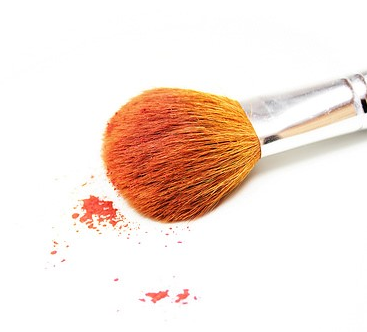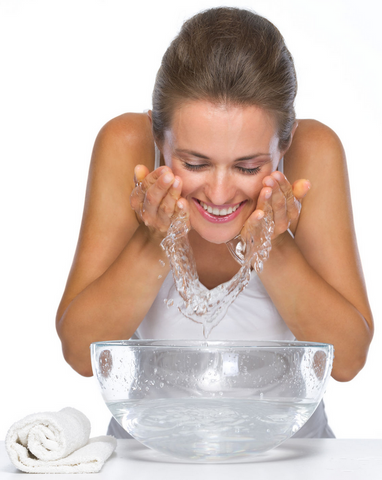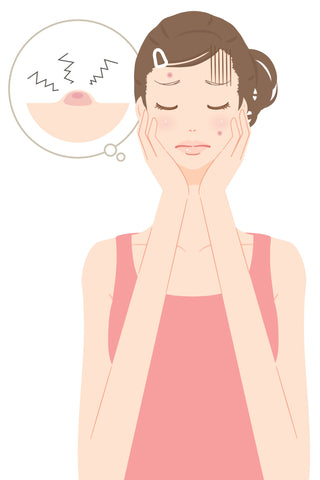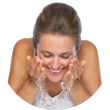
According to the American Academy of Dermatology, between 40 to 50 million Americans suffer from acne each year. While teenagers and young adults claim the highest population of acne sufferers, acne can strike at any age. Adult acne often causes embarrassment and frustration, but you can regain control over your skin and beat the breakouts by establishing an effective skin care regimen that doesn't include harsh chemicals.
Monitor Your Makeup Use
While you might feel tempted to cover up your blemishes with layers of makeup, you could actually make the problem worse if you select the wrong product. WebMD advises men and women to choose skin-care products that don't contain oil, grease, or rich ingredients, such as cocoa butter.

Look for mineral-based makeup products that list water as the first ingredient. These products won't contribute to your breakouts or aggravate it, and they'll even out your skin tone and complement your complexion. If you have sensitive skin, look for products with the fewest ingredients because they're less likely to irritate your skin.
Avoid applying makeup to your skin if you plan to stay home all day or if you feel comfortable facing the world without anything to cover up your face. Allowing your skin to breathe can hasten the healing process and allow breakout medications to work uninhibited. When you wear makeup, wash your skin thoroughly at night to remove all traces of the product.
Don't forget to clean your makeup brushes and sponges, too. Dirty application utensils can spread bacteria, irritate skin, and clog pores. If your applicators start to break down or if you can't get them clean, replace the applicators with fresh ones.
Men who are dealing with breakouts should avoid harsh shaving lotions and aftershave products. If you experience razor burn easily, you might ask your physician for a prescription shaving gel or foam that will make getting a close shave without injuring your skin easier.
Exfoliate Once Per Week
A gentle exfoliant removes dead skin cells and revitalizes your skin's structure to promote effective healing. Breakouts often results from clogged pores, so start an exfoliation routine to open your pores and allow them to breathe. Consider using an exfoliant scrub with vitamin C, which helps your skin recover from blemishes, such as blemishes, and sun exposure damage.
Harsh exfoliants, however, can inflict more harm than benefits. Avoid intense scrubs and peels that could further damage your skin or promote breakouts. If your skin reddens after you exfoliate, you might need a gentler product.
After you exfoliate, apply moisturizer to keep your skin soft and hydrated. Since exfoliants can dry out skin, you don't want to leave your pores unprotected. Some people believe that moisturizers encourage breakouts, but as long as you choose a light, oil-free product, you'll enjoy healthier skin without promoting blackheads.
Wash Your Face Twice

If you wear makeup, you might need to wash your face twice in the evenings instead of only once. The first scrub removes all the product that covers your skin, from makeup to sunscreen. When you wash your face again, you'll tackle any bacteria that might have penetrated your pores.
Avoid dual washing in the morning because your skin won't need cleansing from other products. Too much washing can irritate and dry out your skin, especially if you already have dry skin.
When washing your face, avoid towels and wash cloths. The fibers can rub against your pores and inflame them, which will exacerbate your breakouts. Instead, use cool, clean water and your hands to apply your face wash and rinse the wash away.
Don't scrub at your face with your hands, either, because the friction will only irritate your skin. Instead, use gentle, circular motions when applying and rinsing off a cleanser. Always follow the directions on the bottle or jar. For example, some facial cleansers require you to leave the product on your skin for a minute or two to allow them to work properly.
As with exfoliants, moisturize your skin after you wash it. The best moisturizers for breakout-prone skin are noncomedogenic, which means these products don't promote or cause breakouts. Look for noncomedogenic on the labels.
Avoid Drying Products
Some anti-blemish creams contain drying agents such as benzoyl peroxide, which can help ease breakouts in certain cases — particularly among teenagers. However, many adults can't tolerate the intense drying effects and might experience cracked skin and red blemishes the longer they use the product.
In fact, your skin might respond by producing more oil to compensate for the dryness. Oil production contributes to increased blemishes and other symptoms, so choose products that moisturize and tone the skin instead of drying it.
Other products and habits can also dry out your skin. For example, if you take hot showers, the scalding water could strip your skin of natural oils. Similarly, if you spend too much time in the sun, you might experience drier skin. Wear moisturizing sunscreen to protect your face from UV rays.
Drink plenty of water to stay hydrated. Keep a bottle of water with you all day or make a point to drink a glass of water each morning when you get up and every evening before you go to bed.
Apply a Mud Mask
After you wash, exfoliate, and moisturize your face, consider applying a mud mask that detoxifies the skin. Only use a mask once or twice a month to enhance your complexion and smooth away blemishes. The healing properties in masks can also help control adult breakouts, which thrives on the oil and dirt that can congregate deep in your pores.
Most mud masks should harden on your face for 10 to 20 minutes. Afterward, you'll gently remove the mask with your fingers, avoiding cloths and towels that could irritate your skin. Don't fall asleep while wearing a mud mask unless the directions tell you to wear the mask overnight because the hardened shell won't allow your skin to breathe.
In addition to fighting breakouts, face masks and mud masks minimize the appearance of scars that breakouts can leave behind. If your skin features permanently dark areas, for instance, you can use a mask to even out your complexion and restore balance to your skin.
Plus, an at-home mud mask costs much less to apply than a trip to a spa or wellness center. You don't need a professional to apply a mask or a doctor to prescribe one. However, if you experience any negative side effects from the mask, such as red or blotchy skin, stop using the mask immediately.
Pay Attention to Items That Touch Your Face

Your face comes into contact with multiple items every day, from your smartphone to your pillowcase. Cleaning or refreshing those items can prevent adult breakouts from leaving blemishes on your skin and causing embarrassment.
Clean your phone at least once per day with rubbing alcohol wipes or a similar product. Never submerge your phone in water or clean the device with soap. You can dip a cotton swab in rubbing alcohol and use the wet end to clean around the edges of your phone case or between the keys if your phone has them. Read the instruction manual that came with your phone to find individualized instructions for cleaning.
When possible, use a soft pillowcase that won't cause friction when the material rubs against your face. Satin and silk pillowcases make excellent choices, as cotton and polyester can irritate your skin. Wash your pillowcases and other sheets at least once per week.
Avoid harsh detergents and scented fabric softeners and dryer sheets. These products introduce irritating chemicals that might exacerbate your breakouts. Look for laundry products designed for sensitive skin or with hypoallergenic uses in mind.
You might also want to look at your hair care regimen. If you layer heavy or oil-based products on your head, you might see pimples pop up along your hairline or across your forehead. Reducing the amount of product you put in your hair, from hairspray to mousse, can ease your breakouts. Wash your hair daily to remove excess oils or talk with your doctor about the best hair care regimen for your body.
Visit the Doctor
In addition to seeing a dermatologist about adult breakouts, you might want to schedule an appointment with an endocrinologist. These health care professionals focus on hormone imbalances and other conditions that might impact your skin. Postmenopausal women, in particular, might have this problem.
Hormone imbalances can cause breakouts, excess oil production, and dry skin. Pay attention to your body and tell your doctor if you have any other related symptoms, such as the following:
- Weight gain or loss
- Fatigue
- Difficulty sleeping
- Dry skin and scalp
- Brittle nails
- Carbohydrate cravings
- Inability to concentrate
If you doctor finds a problem, your physician can prescribe medication. For example, if you have an underactive thyroid, your physician might prescribe levothyroxine to bring up your levels. Other hormone imbalances are likewise treatable.
While there's no guarantee that medication alone will clear up your blemishes, taking a holistic approach to your health is important. Often, solving one problem clears up others as well. Both men and women can develop hormone imbalances, so visit your doctor often for annual checkups.
Take Your Vitamins

Certain vitamins, such as A and C, help keep your skin healthy and hydrated. If you don't get enough of these vitamins through your diet, you can add oral supplements to your skin care regimen. Look for individual vitamins as well as daily multivitamins to make sure your body has all the resources needed to keep you healthy.
You can add vitamins A and C to your diet naturally by consuming citrus fruits, berries, bell peppers, sweet potatoes, fish, and leafy greens. Some topical medications contain these vitamins and might work more effectively than dietary changes. Experiment with different methods of consuming your vitamins to decide which method works best for you.
Vitamin E and zinc deficiencies might also contribute to adult breakouts. If you're concerned about these deficiencies, ask your doctor to run a blood panel to check for vitamin and mineral deficiencies so you'll know how to handle your specific situation. Even if you don't have a deficiency, adding a multivitamin to your diet might help you control breakouts.
Watch Your Diet and Stress Levels
Sometimes, adult breakouts results from lifestyle choices that you can control once you identify them. For example, stress might add to clogged pores and unhealthy skin, especially if you don't get enough sleep. Rearrange your schedule so that you can get at least six to eight hours of sleep every night. Not only will your skin's condition improve, but you'll also feel better prepared to tackle the day's activities.
Try to cut other sources of stress, such as professional struggles and familial issues. Devote at least one hour of every day to a relaxing and enjoyable activity. Take a walk around the block, read a book, or watch a favorite television program.
Many people who suffer from adult breakouts avoid exercise because they worry that sweat production will lead to more frequent breakouts. Sweat, however, can actually help cleanse your pores because the sweat pushes out dirt and washes toxins from your skin. A half-hour of intense activity can make you feel healthier and improve your complexion at the same time.
You might also want to weed out foods from your diet that cause your blood sugar levels to increase. Sugary drinks and snacks might prove dangerous to your skin, as can foods that are high in fat and cholesterol. Strive for a balanced diet that includes plenty of fruits, vegetables, and lean meats. Substitute whole grains for processed breads when possible. If you suffer from diabetes, carefully follow your doctor's advice to control your insulin levels.
Beating breakouts and controlling blackheads requires a multi-layered approach. From cleansing and moisturizing products to lifestyle changes, you can reduce the frequency of your breakouts and improve your skin's overall health.
Image via Flickr by Trostle




